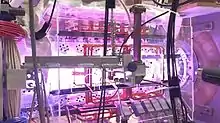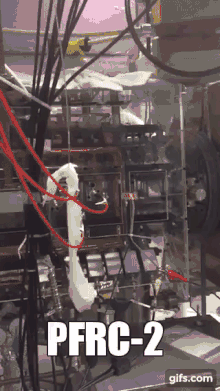Princeton field-reversed configuration
The Princeton field-reversed configuration (PFRC) is a series of experiments in plasma physics, an experimental program to evaluate a configuration for a fusion power reactor, at the Princeton Plasma Physics Laboratory (PPPL). The experiment probes the dynamics of long-pulse, collisionless,[1] low s-parameter[2] field-reversed configurations (FRCs) formed with odd-parity rotating magnetic fields.[3][4] It aims to experimentally verify the physics predictions that such configurations are globally stable and have transport levels comparable with classical magnetic diffusion.[2] It also aims to apply this technology to the Direct Fusion Drive concept for spacecraft propulsion.[5]

History
The PFRC was initially funded by the United States Department of Energy. Early in its operation it was contemporary with such RMF-FRCs as the Translation Confinement Sustainment experiment (TCS) and the Prairie View Rotamak (PV Rotamak).
At PPPL, the experiment PFRC-1 ran from 2008 through 2011.[6] PFRC-2 is running as of 2019. PFRC-3 is scheduled next. PFRC-4 is scheduled for the mid-2020s.[6]
Odd-parity rotating magnetic field
The electrical current that forms the field-reversed configuration (FRC) in the PFRC is driven by a rotating magnetic field (RMF). This method has been well-studied and produced favorable results in the Rotamak series of experiments.[7] However, rotating magnetic fields as applied in these and other experiments (so-called even parity RMFs) induce opening of the magnetic field lines. When a transverse magnetic field is applied to the axisymmetric equilibrium FRC magnetic field, rather than magnetic field lines closing on themselves and forming a closed region, they spiral around in the azimuthal direction and ultimately cross the separatrix surface which contains the closed FRC region.[3]

The PFRC uses RMF antennae which produce a magnetic field which changes direction about a symmetry plane oriented with its normal along the axis, half-way along the length of the axis of the machine. This configuration is called an odd parity rotating magnetic field. Such magnetic fields, when added to axisymmetric equilibrium magnetic fields, do not cause opening of the magnetic field lines.[3] Thus, the RMF is not expected to contribute to transport of particles and energy out of the core of the PFRC.
Low s-parameter
In an FRC, the name s-parameter is given to the ratio of the distance between the magnetic null and the separatrix, and the thermal ion Larmor radius. That is how many ion orbits can fit between the core of the FRC and where it meets the bulk plasma.[2] A high-s FRC would have very small ion gyroradii compared to the size of the machine. Thus, at high s-parameter, the model of magnetohydrodynamics (MHD) applies.[8] MHD predicts that the FRC is unstable to the "n=1 tilt mode," in which the reversed field tilts 180 degrees to align with the applied magnetic field, destroying the FRC.
A low-s FRC is predicted to be stable to the tilt mode.[8] An s-parameter less than or equal to 2 is sufficient for this effect. However, only two ion radii between the hot core and the cool bulk means that on average only two scattering periods (velocity changes of on average 90 degrees) are sufficient to remove a hot, fusion-relevant ion from the core of the plasma. Thus the choice is between high s-parameter ions that are classically well confined but convectively poorly confined, and low s-parameter ions that are classically poorly confined but convectively well confined.
The PFRC has an s-parameter between 1 and 2.[2] Stabilizing the tilt-mode is predicted to aid confinement more than the small number of tolerable collisions will hurt confinement.
Spacecraft propulsion
Scientists from Princeton Satellite Systems are working on a new concept called Direct Fusion Drive (DFD) that is based on the PFRC. It would produce electric power and propulsion from a single compact fusion reactor. The first concept study and modeling (Phase I) was published in 2017,[9] and was proposed to power the propulsion system of a Pluto orbiter and lander.[9][10] Adding propellant to the cool plasma flow results in a variable thrust when channeled through a magnetic nozzle. Modeling suggests that the DFD might produce 5 Newtons of thrust per each megawatt of generated fusion power.[11] About 35% of the fusion power goes to thrust, 30% to electric power, 25% lost to heat, and 10% is recirculated for the radio frequency (RF) heating.[9] The concept has advanced to Phase II[11] to further advance the design and shielding.
References
- Cohen, S. A.; Berlinger, B.; Brunkhorst, C.; Brooks, A.; Ferraro, N.; Lundberg, D. P.; Roach, A.; Glasser, A. H. (2007). "Formation of Collisionless High-β Plasmas by Odd-Parity Rotating Magnetic Fields". Physical Review Letters. 98 (14): 145002. Bibcode:2007PhRvL..98n5002C. doi:10.1103/physrevlett.98.145002. PMID 17501282.
- Cohen, Samuel A. (June 4, 2008). "Field-reversed configuration: Community input to FESAC" (PDF). General Atomics Fusion Energy Research. General Atomics. Retrieved December 11, 2015.
- Cohen, S. A.; Milroy, R. D. (2000-06-01). "Maintaining the closed magnetic-field-line topology of a field-reversed configuration with the addition of static transverse magnetic fields". Physics of Plasmas. 7 (6): 2539–2545. Bibcode:2000PhPl....7.2539C. doi:10.1063/1.874094. ISSN 1070-664X.
- Glasser, A. H.; Cohen, S. A. (2002-05-01). "Ion and electron acceleration in the field-reversed configuration with an odd-parity rotating magnetic field". Physics of Plasmas. 9 (5): 2093–2102. Bibcode:2002PhPl....9.2093G. doi:10.1063/1.1459456. ISSN 1070-664X.
- Paluszek, Michael; Thomas, Stephanie (2019-02-01). "Direct Fusion Drive". Princeton Satellite Systems. Retrieved 2019-06-17.
- Wall, Mike (2019-06-11). "Fusion-Powered Spacecraft Could Be Just a Decade Away". Space.com. Future US. Retrieved 2019-06-17.
- Jones, Ieuan R. (1999-05-01). "A review of rotating magnetic field current drive and the operation of the rotamak as a field-reversed configuration (Rotamak-FRC) and a spherical tokamak (Rotamak-ST)". Physics of Plasmas. 6 (5): 1950–1957. Bibcode:1999PhPl....6.1950J. doi:10.1063/1.873452. ISSN 1070-664X.
- Barnes, Daniel C.; Schwarzmeier, James L.; Lewis, H. Ralph; Seyler, Charles E. (1986-08-01). "Kinetic tilting stability of field‐reversed configurations". Physics of Fluids. 29 (8): 2616–2629. Bibcode:1986PhFl...29.2616B. doi:10.1063/1.865503. ISSN 0031-9171.
- Thomas, Stephanie (2017). "Fusion-Enabled Pluto Orbiter and Lander – Phase I Final Report" (PDF). NASA Technical Reports Server. Princeton Satellite Systems. Retrieved 2019-06-14.
- Hall, Loura (April 5, 2017). "Fusion-Enabled Pluto Orbiter and Lander". NASA. Retrieved July 14, 2018.
- Thomas, Stephanie J.; Paluszek, Michael; Cohen, Samuel A.; Glasser, Alexander (2018). Nuclear and Future Flight Propulsion – Modeling the Thrust of the Direct Fusion Drive. 2018 Joint Propulsion Conference. Cincinnati, Ohio: American Institute of Aeronautics and Astronautics. doi:10.2514/6.2018-4769. Retrieved 2019-06-14.
External links
- Official website, Princeton Plasma Physics Laboratory
- Professor Samuel A. Cohen
